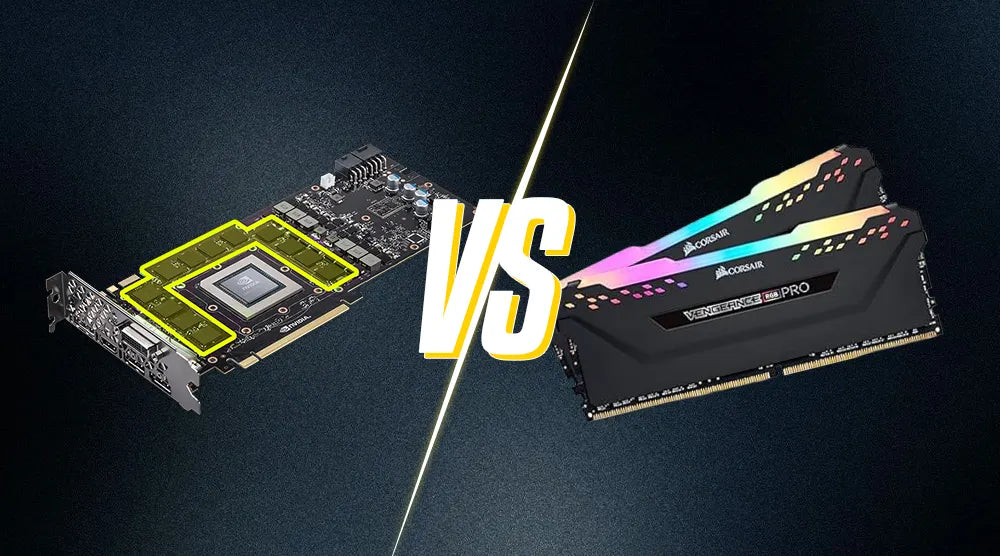In the field of gaming performance, memory matters, though all are not alike. Two categories dominate in vogue form in frequent cycles, and these two are VRAM (Video RAM) and RAM (Random Access Memory).
Despite both needing presence, if you understand what each one contributes towards your gaming rig, then you can perform even better upgrade activities and gain the utmost performance.
In this blog, we will compare VRAM vs RAM, explain when each one matters most for gaming and productivity, and assist you in determining what precisely your system requires in 2025.
What Is RAM and Why Does It Matter?
RAM, or Random Access Memory, is the computer's short-term memory. It holds temporary data that your CPU must access immediately, such as when you are multitasking, loading game information, or running background applications.
Importance of RAM for Gaming
-
Game Loading: RAM preloads significant game information into memory so that your CPU can immediately access it.
-
Multitasking: Enables playing while having browser tabs, music software, Discord, etc., open in the background.
-
System Responsiveness: More RAM allows for smoother transitions and faster overall operations.
Though RAM has nothing to do with the graphics itself, it keeps the system running smoothly without any bottleneck.
What Is VRAM and Why It's Important for Gamers?
VRAM (Video RAM) is a location on your graphics card (GPU). It's used to store visual information such as textures, shaders, frame buffers, and graphical assets. VRAM enables images to be rendered at high quality and cost-effectively.
How VRAM Affects Your Gaming Experience
-
Resolution & Texture Quality: Higher VRAM, sharper textures, and smoother gameplay at 1440p or 4K.
-
Frame Rates: If you have sufficient VRAM, your GPU never lags behind drawing frames, and you receive steady FPS.
-
Graphical Settings: Ray tracing and HD textures take up more VRAM.
Real-World Scenarios
-
High-Result Gaming (4K): In this scenario, the role of VRAM is more. Low VRAM provides you with fuzzy textures and frame drops.
-
Having Multiple Background Programs Running: In this scenario, RAM comes into play. You can stutter if your computer does not have enough RAM.
So, in the battle of VRAM vs RAM, it simply boils down to what you do on your computer and not which is "better."
How to Determine if You Need More RAM or VRAM?
Signs You Need More RAM or VRAM
-
Games freeze during loading.
-
Stutter while multitasking.
-
Lag while changing tabs or programs.
-
Symptoms You Need More VRAM.
-
Texture pop-ins or delayed rendering.
-
High FPS at resolutions.
-
Visuals automatically scale back.
Recommended Specs by Gaming Category
Casual Gaming (1080p):
-
RAM: 8GB–16GB
-
VRAM: 4GB–6GB
Competitive Gaming (1440p):
-
RAM: 16GB
-
VRAM: 8GB
Ultra Settings / Streaming (4K):
-
RAM: 32GB
-
VRAM: 12GB–16GB
|
Feature |
RAM |
VRAM |
|
Function |
System operations & multitasking |
Graphics rendering |
|
Location |
Motherboard |
GPU |
|
Used by |
CPU |
GPU |
|
Impacts |
App switching, load times |
Resolution, textures, FPS |
|
Ideal Upgrade For |
Sluggish multitasking |
Choppy or low-res graphics |
Balancing Both for the Best Experience
To truly optimize gaming performance, you’ll need a well-balanced mix of both RAM and VRAM. Even the best GPU with 16GB VRAM can underperform if paired with only 8GB RAM, and vice versa.
Tips to Enhance Both:
-
Verify memory usage through Task Manager (RAM) and GPU-Z (VRAM).
-
Turn off unnecessary programs before playing games.
-
De-escalate game settings according to your system's slower memory type.
-
Thoughtful investment according to your game use keeps your systems running longer and better.
Final Thoughts
The debate of VRAM vs RAM isn’t about which is "better"; it’s about what you need. For highly graphics-intensive Gaming, VRAM is superior. However, when you have a lot of things going on at the same time or programs running aside from playing a game, RAM is superior.
Knowing the difference between VRAM and RAM helps you avoid bottlenecks, optimize frame rates, and provide maximum performance within your budget.
Want more expert PC-building tips?
Explore the Technoid Inc. Blog for the latest guides on gaming hardware, benchmarks, and tech innovations!
FAQs
1. Can you upgrade additional VRAM as we upgrade RAM?
No, your GPU has built-in VRAM that cannot be upgraded independently. If you want additional VRAM, you would have to change graphics cards.
2. Will 8GB RAM be sufficient for gaming in 2025?
Yes, for casual games. But for new AAA games or multitasking, 16GB or more is advised.
3. Do integrated GPUs utilize system RAM as VRAM?
Yes, part of system RAM is utilized by integrated GPUs as video memory, and that can be a bottleneck.
4. How do I know how much VRAM and RAM I have?
Verify using Windows Task Manager (for RAM) and GPU-Z or Display settings under System > Display > Advanced Display for VRAM.

 United States
United States

